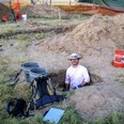
Presentation
Precision in 3D Prints: The Case of MH1 (Australopithecus sediba)
Presented at the 2018 Texas Academy of Science Annual Meeting (Best Undergraduate Poster [Anthropology]), 2018 Student Research Week at Texas A&M University, 2018 9th Annual Anthropology Conference at Texas A&M University (1st Place--Best Undergraduate Poster), and the 2018 American Association of Physical Anthropologists meeting in Austin, Texas. Hammond received a travel grant from AAPA to present the poster, and $750 from the Department of Anthropology at Texas A&M University in support of this project.
(2018)
Abstract
The use of three-dimensional (3D) printed models of hominin fossils is becoming more common in biological anthropology, due in part to their low production cost. Digital meshes are also more accessible than casts, further increasing the reach and impact of specimens. An inherent trust in scanning protocols and printers underlies the utilization of prints, though scanner type, processing techniques, environmental variables, and proprietary algorithms used by 3D printers also influence the way that 3D prints convey the topology of the original scan. The type specimen of Australopithecus sediba (MH 1) is used to highlight these issues. In this study we assess the precision of five different brands of 3D printers, and subsequently the repeatability and reliability of a single printer. The original scan data are compared to the printed/scanned (measured) data in Geomagic Control X using a comparison to identify global deviations, a 2D comparison to identify deviations for specific curves used in geometric morphometric (GM) analyses, and a suite of comparison points to compare deviations of specific locations on the mesh surface. Results demonstrate broad similarities between prints; however, variability is detected on a smaller scale using an 0.1 mm tolerance. This project quantitatively demonstrates which 3D printer produces models most closely resembling original specimens--based upon currently-deployed settings and environmental configurations--and repeatable replication of models from a single printer. Through critical assessment, this project makes clear the implications and risks associated with the reuse of archived 3D meshes in research, teaching, and museum-based endeavors.
Keywords
- Australopithecus sediba,
- 3d print,
- 3d scan,
- replication,
- computer aided inspection
Publication Date
2018
Citation Information
Lauren Hammond, Kersten Bergstrom, Robert Z. Selden and Darryl J de Ruiter. "Precision in 3D Prints: The Case of MH1 (Australopithecus sediba)" Presented at the 2018 Texas Academy of Science Annual Meeting (Best Undergraduate Poster [Anthropology]), 2018 Student Research Week at Texas A&M University, 2018 9th Annual Anthropology Conference at Texas A&M University (1st Place--Best Undergraduate Poster), and the 2018 American Association of Physical Anthropologists meeting in Austin, Texas. Hammond received a travel grant from AAPA to present the poster, and $750 from the Department of Anthropology at Texas A&M University in support of this project. (2018) Available at: http://works.bepress.com/zac_selden/218/
Creative Commons License

This work is licensed under a Creative Commons CC_BY-NC-ND International License.
